

New York City Mayor Eric Adams has spent his first nine months on the job tackling the crime problem that helped propel him to victory last year.
But his tough approach has met resistance from liberal activists, who warn of a return to policing tactics that the criminal justice movement has fought hard to end.
Adams has troubled some activists with a focus on policing lower-level crimes that, under the leadership in many other progressive cities, tend to go unpunished.
DEMOCRATS HAVE EARNED THEIR SOFT-ON-CRIME REPUTATION
For example, Adams began pushing earlier this year for prosecutors to go after people who jump turnstiles on the subway to evade fares, arguing that allowing New Yorkers to skip out on paying “sent the wrong message.”
“If we start saying it’s all right for you to jump the turnstile, we are creating an environment where any and everything goes,” Adams said in March.
The mayor has pushed police to crack down on public drinking and drug use as well.
In other cities, liberal leaders have taken opposite steps in recent years to reduce policing of such offenses, known as quality of life crimes. In Philadelphia, for instance, the city’s liberal district attorney instituted a policy of declining to prosecute crimes like marijuana dealing and prostitution.
Philadelphia’s crime rates have soared.
Former San Francisco District Attorney Chesa Boudin came into office in 2019 vowing to stop prosecuting quality of life crimes as well. Dissatisfaction with his public safety record led San Francisco voters to recall him earlier this year, and his replacement has promised to restore a sense of safety to the city by going after street crimes her predecessor ignored.
Since Adams’s anti-crime push began in the spring, the New York Police Department has reported an increase in arrests.
The number of gun arrests reached a 27-year high in August, according to NYPD data. Felony arrests also rose significantly in the first eight months of 2022 when compared with the same time frame last year, even as the number of shootings began to fall.
The campaign to rid the streets of illegal guns has proven one of Adams’s most controversial moves on crime.
Adams made waves with his decision to resurrect a policing unit that the city disbanded amid the protests following George Floyd’s murder in 2020. The incoming mayor quickly followed through on a promise to bring back “anti-crime units” made up of plainclothes officers that are charged with targeting gun crimes.
The neighborhood safety teams had racked up hundreds of arrests in their first two months for crimes that often went beyond illegal gun possession, deepening the concerns of critics.
Some progressive city council members balked at the plan.
City Councilman Chi Osse suggested the units wasted resources that could be better spent on concerns he hears more regularly from New Yorkers, such as housing issues.
“I think we are at a time where many of our communities and constituencies have a different understanding and feeling for what public safety truly means,” Osse said.
Osse also recalled being searched by police as a teenager during the height of the “stop and frisk” era, during which police relied on, and occasionally abused, the ability to question and search anyone of whom they had reasonable suspicion.
“People within my community have a fear of this new ‘anti-crime unit’ or ‘neighborhood safety unit,’ so I do have skepticism,” Osse said.
Adams has sought to distinguish his new crime crackdown from policies that have become toxic within his party, such as the “broken windows” policing of the 1990s.
The broken windows law enforcement theory holds that targeting lower-level crimes aggressively reduces violent crimes as well.
Adams has specifically pushed back on the idea that his approach mirrors broken windows policing. But critics have continued to accuse him of undoing liberal criminal justice reforms.
The left-leaning Legal Aid Society, for example, stated in a report earlier this year that the NYPD’s pursuit of quality of life offenders would risk “further alienating the residents of predominantly Black and Latinx neighborhoods being targeted for the most aggressive enforcement.”
Brooklyn Borough President Antonio Reynoso accused Adams of drawing from sensational, isolated incidents to justify his public safety strategy.
“Instead of responding to data and facts, we’re responding to personal anecdotes and personal experience, and that’s a problem,” Reynoso said in March. “When you’re using moments to dictate policy as opposed to long-term trends, it becomes troublesome.”
Reynoso argued the city should invest more in services for New Yorkers than policing.
CLICK HERE TO READ MORE FROM THE WASHINGTON EXAMINER
“We’re seeing most of these crimes … they’re happening from people that need help,” he said.
Activists have joined with critical members of New York City’s government to call on Adams to take a softer approach toward crime.
City Councilwoman Sandy Nurse joined a rally against Adams’s gun violence prevention plan, arguing alongside activists this year that violence “is a public health crisis, and it needs public health solutions.”






